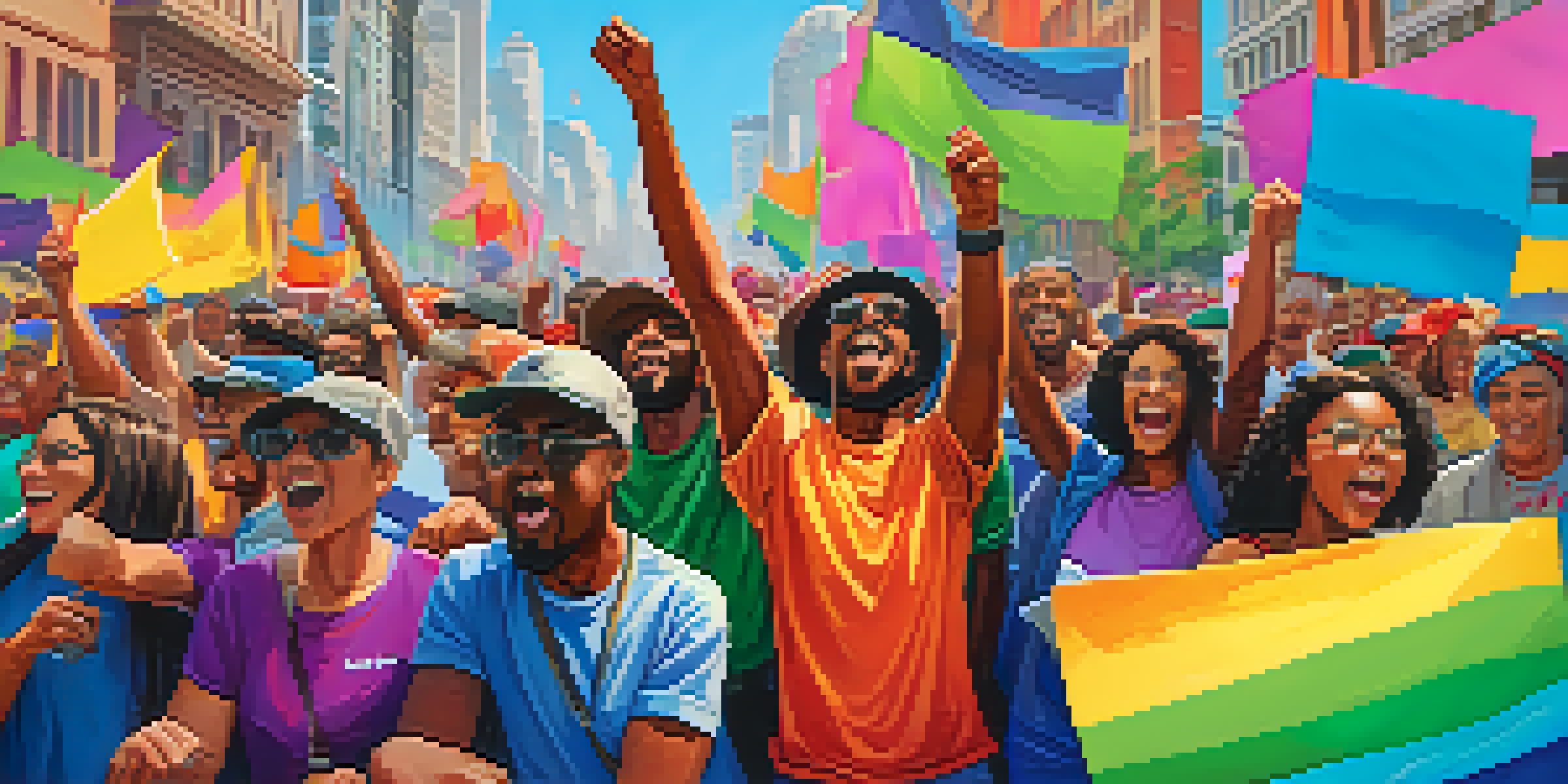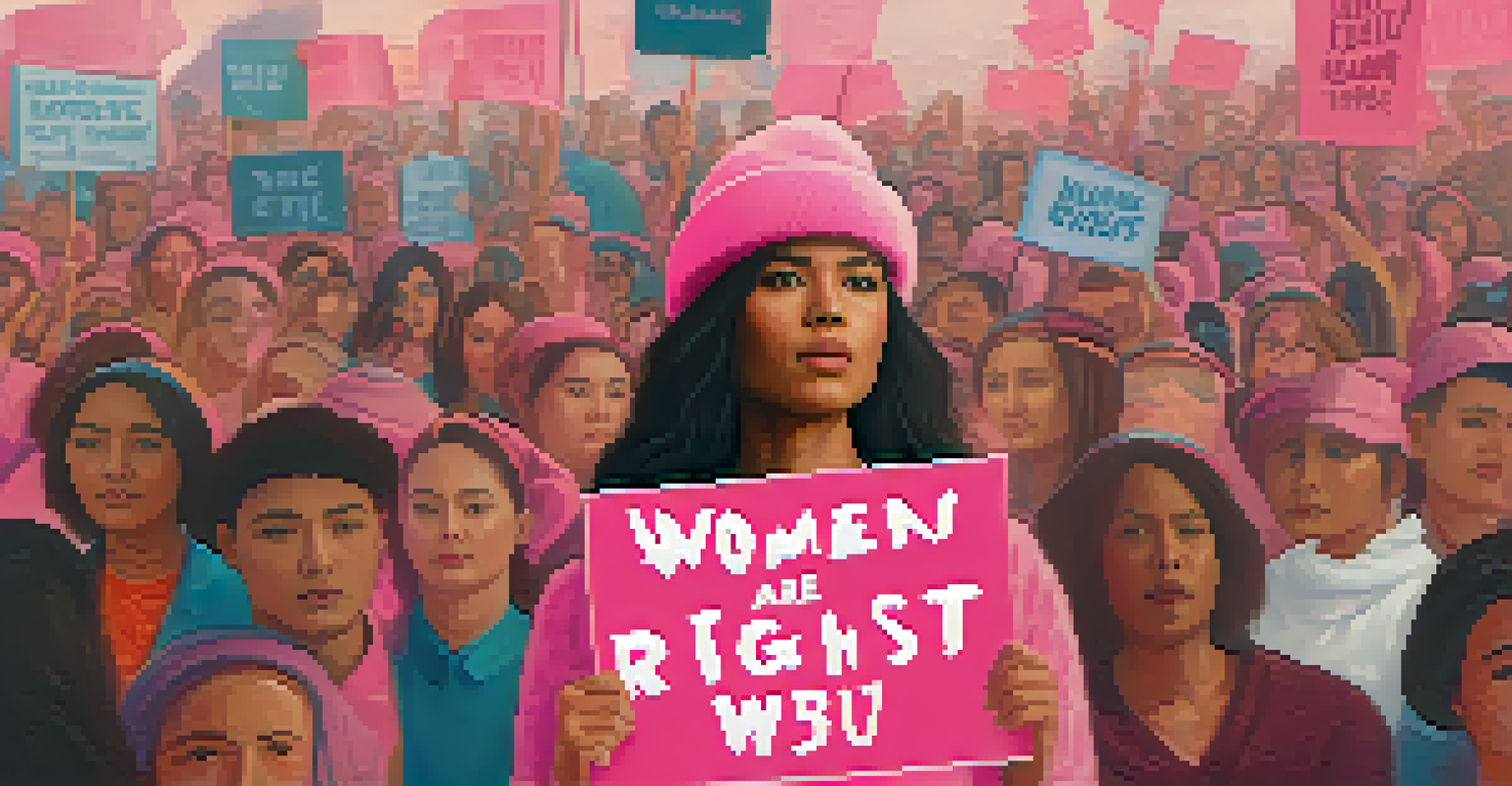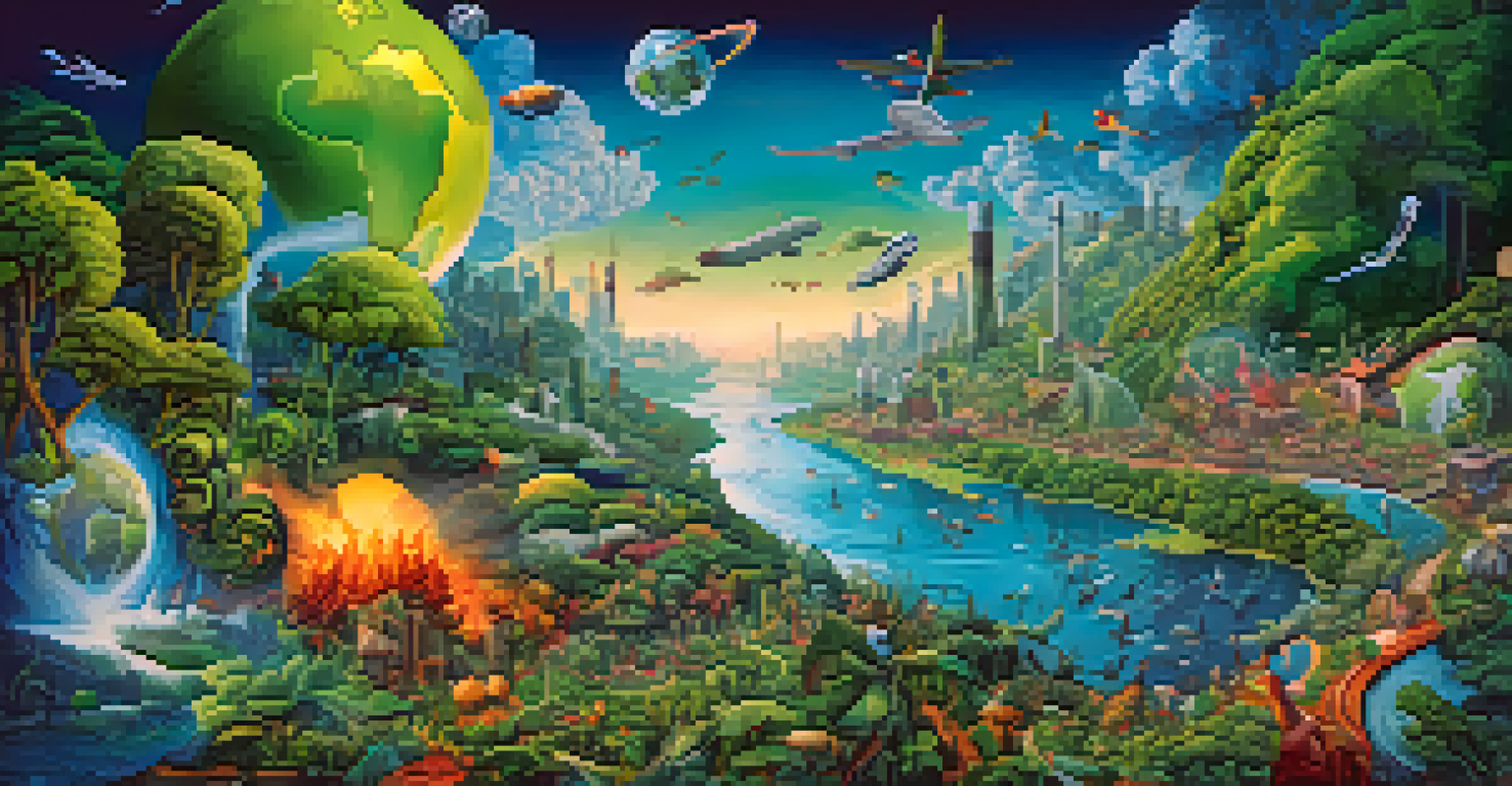Digital Art as Protest: Iconic Examples from Recent History

The Rise of Digital Art in Activism
Digital art has emerged as a potent medium for protest, especially in recent years. With the advent of social media and digital platforms, artists can quickly share their work with a global audience. This shift has empowered marginalized voices, allowing them to express their grievances and hopes through compelling visuals. The immediacy of digital art makes it an effective tool in the fast-paced world of activism, where a single image can spark widespread dialogue.
Art is not a mirror to hold up to society, but a hammer with which to shape it.
As artists harness technology, digital art becomes not just a form of expression but a rallying cry for change. For instance, during the Black Lives Matter movement, artists utilized platforms like Instagram to share powerful illustrations and memes that resonated with many. This accessibility means that anyone with a smartphone can engage with and contribute to ongoing conversations, democratizing the art of protest.
Moreover, the fluid nature of digital art allows for rapid adaptation and reinterpretation. An artwork can evolve as it gets shared, taking on new meanings and reaching different audiences. This adaptability is crucial in activism, where messages need to be timely and relevant. Digital art thrives on this dynamism, making it a vital component of modern protest.
Iconic Examples of Digital Protest Art
One iconic example is the artwork that emerged during the Women's March, which took place in various cities worldwide. Artists created striking visuals of female empowerment that were widely shared online, portraying the strength and resilience of women. The pink 'pussy hats' became a symbol of solidarity, inspiring countless digital renditions that spread across social media platforms. This art not only captured the essence of the movement but also encouraged participation and awareness globally.

Another powerful instance can be seen in the digital art surrounding climate change protests, like those led by Greta Thunberg. Artists have crafted poignant illustrations highlighting the urgency of the climate crisis, using stark imagery to evoke emotional responses. These digital pieces often accompany hashtags and campaigns that draw attention to the cause, making them integral to the broader environmental movement. They serve to inform and mobilize audiences, translating complex issues into relatable visuals.
Digital Art Fuels Activism
The rise of digital art has transformed activism by empowering marginalized voices and allowing for rapid sharing and adaptation of powerful messages.
Additionally, the street art of Banksy has transitioned into the digital realm, where his work continues to provoke thought and discussion. His pieces often critique political systems and social injustices, and the ability to share them online amplifies their impact. For example, during the COVID-19 pandemic, Banksy released artwork addressing themes of isolation and resilience, which resonated deeply with many. Each piece invites viewers to engage with pressing societal issues in a new light.
Social Media: A Catalyst for Digital Art Protests
Social media platforms have played a crucial role in the dissemination of digital protest art. With the ability to reach millions in an instant, artists can share their messages far beyond their local communities. This widespread sharing creates a ripple effect, amplifying voices that might otherwise go unheard. Platforms like Twitter, Instagram, and TikTok have become digital canvases for activism, where art and message intertwine seamlessly.
The power of art is that it allows us to see the world through someone else's eyes.
Moreover, hashtags have become essential tools in organizing and spreading awareness. For instance, #ArtForBlackLives and #ClimateStrikeArt have united artists and activists, encouraging the creation of works that reflect their values and demands. These hashtags not only make art discoverable but also foster a sense of community among creators and supporters alike. In this way, social media serves as a powerful ally in the quest for social justice.
The interactive nature of social media also invites engagement from audiences, allowing them to contribute their own art and perspectives. This collaborative environment leads to a richer dialogue around the issues, as diverse voices come together to share their visions for change. When art becomes a participatory experience, it deepens the impact of the message and encourages continued action.
The Power of Visual Storytelling in Activism
Visual storytelling is a fundamental aspect of digital art as protest. Artists often distill complex social issues into relatable images that resonate with viewers. This simplification allows audiences to grasp difficult concepts quickly and emotionally connect with the cause. Think of powerful images from protests that capture the essence of a movement—these visuals linger in our minds and spur action.
For example, the use of infographics in digital art can effectively communicate statistics and facts that highlight social injustices. These graphics break down overwhelming information into digestible chunks, making it easier for people to understand and share. When art combines with data, it creates a compelling narrative that can sway opinions and inspire collective action.
Social Media Amplifies Impact
Social media platforms serve as vital tools for artists to disseminate their work, fostering community and engagement around social justice issues.
Furthermore, the emotional weight of visual storytelling can prompt viewers to reflect on their own experiences and beliefs. Art can evoke empathy and understanding, bridging the gap between different perspectives. In this way, digital art becomes a powerful tool for fostering dialogue and driving social change, as it encourages people to not only see but feel the urgency of the issues at hand.
Challenges Faced by Digital Protest Artists
Despite the benefits of digital art in activism, artists face several challenges. One significant issue is the risk of censorship, especially when tackling sensitive political topics. Platforms may remove or restrict content that doesn't align with their policies, hindering the artist's ability to share their message. This censorship can discourage artists from speaking out, creating a chilling effect on creative expression.
Additionally, the fast-paced nature of digital media can lead to art being co-opted or diluted. As images spread, they may lose their original context or intention, leading to misinterpretation. This phenomenon raises questions about authenticity and ownership, as artists grapple with how their work is perceived and utilized by others. Navigating this landscape requires artists to be vigilant about their message and how it might be altered in the digital sphere.
Lastly, the sheer volume of content online can make it challenging for individual pieces to stand out. With so much digital noise, important messages can get lost amidst trends and distractions. As a result, artists must continuously innovate and find unique ways to present their work, ensuring their voice is heard in the crowded space of activism.
The Future of Digital Art in Social Movements
Looking ahead, the potential for digital art in social movements is immense. As technology continues to evolve, artists will find new ways to engage audiences and amplify their messages. Virtual reality (VR) and augmented reality (AR) are emerging tools that can create immersive experiences, drawing people into the heart of social issues. These technologies have the power to transform how we perceive and interact with art, offering fresh avenues for protest.
Moreover, the ongoing growth of online communities dedicated to social justice will provide a supportive platform for artists. As these communities expand, they will foster collaboration and provide resources for creators looking to make an impact. This interconnectedness will facilitate the sharing of ideas and strategies, leading to more innovative and effective forms of digital protest art.
Challenges in Digital Expression
Despite its advantages, digital protest art faces challenges such as censorship, misinterpretation, and competition in a crowded online space.
Finally, as awareness of digital art's role in activism spreads, we can expect increased recognition for artists who tackle social justice issues. This validation may encourage more creators to use their talents for advocacy, resulting in a richer tapestry of voices and perspectives. In this way, digital art will continue to be a vital force in shaping the future of social movements.
Conclusion: Digital Art as a Lasting Force for Change
In conclusion, digital art has proven to be a powerful tool for protest and social change. Its accessibility, adaptability, and emotional resonance enable it to connect with diverse audiences and inspire action. From iconic pieces that define movements to the collective energy found on social media, digital art encapsulates the spirit of activism in our time.
As we reflect on the impact of digital art, it's essential to recognize the challenges artists face in this dynamic landscape. Censorship, misinterpretation, and the overwhelming volume of content can hinder their efforts. However, the resilience and creativity of artists often shine through, pushing boundaries and driving conversations forward.

Ultimately, digital art will continue to play a vital role in shaping social movements, offering a unique blend of creativity and activism. As technology evolves, so too will the ways in which we engage with art and the messages it conveys. This ongoing relationship between art and activism is not just a trend; it's a lasting force for change.